Full title
DNADIVE: eDNA Detection for crayfish invasIVE species in streams of Luxembourg: Development of a molecular toolbox

This public-public research project is supported by the
Luxembourg National Research Fund (PUBLIC2-17/SR/11816664)
Contents
Abstract
 DNADIVE aims at developing a toolbox for the molecular monitoring of invasive crayfish in the streams of Luxembourg. Three exotic species (Orconectes limosus, Pacifastacus leniusculus and Astacus leptodactylus) and a native one (Astacus astacus) will be targeted during this project. This molecular toolbox will encompass several techniques of detection comprising (1) a simple amplification method easily performed in a laboratory with few elements, (2) a digital droplet amplification (ddPCR) which is a more elaborated lab method that can allow for a higher detection sensitivity and a possible quantification of DNA that could be related through the proxy of biomass and abundance to the size of the populations detected and (3) an isotherm amplification method (iPCR) i.e. a simple, cost effective approach which will allow for a field detection usable by non-trained agents. The results will enable the development of a predictive species distribution model for the target species and allow to infer their impact on freshwater communities through the comparison with previous sampling campaigns.
DNADIVE aims at developing a toolbox for the molecular monitoring of invasive crayfish in the streams of Luxembourg. Three exotic species (Orconectes limosus, Pacifastacus leniusculus and Astacus leptodactylus) and a native one (Astacus astacus) will be targeted during this project. This molecular toolbox will encompass several techniques of detection comprising (1) a simple amplification method easily performed in a laboratory with few elements, (2) a digital droplet amplification (ddPCR) which is a more elaborated lab method that can allow for a higher detection sensitivity and a possible quantification of DNA that could be related through the proxy of biomass and abundance to the size of the populations detected and (3) an isotherm amplification method (iPCR) i.e. a simple, cost effective approach which will allow for a field detection usable by non-trained agents. The results will enable the development of a predictive species distribution model for the target species and allow to infer their impact on freshwater communities through the comparison with previous sampling campaigns.
This set of methods has the high potential to efficiently contribute to early detection and routine monitoring of the invasive crayfish species in Luxembourg, thus allowing for a timely and efficient decision-making and appropriate management.
Project status
Project funded by Fonds national de la recherche Luxembourg, Musée national d´histoire naturelle Luxembourg, Ministry of sustainable development and infrastructure. Duration: 3 years (01.05.2018 – 30.04.2021).
Project consortium: Fondation faune-flore, Musée national d´histoire naturelle Luxembourg, Luxembourg Institute of Science and Technology, Ministry of sustainable development and infrastructure.
Host institution: Fondation faune-flore @ Centre de recherche scientifique, Musée national d’histoire naturelle.
Contact
 David PORCO
David PORCO
Musée national d’histoire naturelle
Research centre
Life science department
Research units: Invertebrate zoology & Population biology and Evolution
24, rue Münster
L-2160 Luxembourg
phone: (+352) 46 22 33 -264
fax: (+352) 46 38 48
david.porco@mnhn.lu
Publications
Molecular taxonomy (DNA barcoding)
- PORCO D., Chang C., Dupont L., James S., Richard B., Decaëns T. (2017) A reference library of DNA barcodes for the earthworms from Upper Normandy: biodiversity assessment, new records, potential cases of cryptic diversity and ongoing speciation. Applied Soil Ecology – Sous presse.
- Potapov M., PORCO D., Deharveng L. (2017) A new member of the genus Isotomurus from Kuril Islands (Collembola: Isotomidae) : returning to the problem of “color pattern species“. Zootaxa – Soumis.
- Shekhovtsov S.V., Berman D.I., Bazarova N.E., Bulakhova N.A., PORCO D., Peltek S.E. (2016) Cryptic genetic lineages in Eisenia nordenskioldi pallida (Oligochaeta, Lumbricidae) and diversification history of the E. nordenskioldi complex. European Journal of Soil Biology, 75:151-156.
- Dupont L., PORCO D., Symondson W.O.C., Roy V. (2016) Hybridization relics complicate barcode-based identification of species in earthworms. Molecular Ecology Ressources, 16: 883-894.
- Cameron E.K., Decaëns T., Lapied E., PORCO D., Eisenhauer N. (2016) Earthworm databases and ecological theory: Synthesis of current initiatives and main research directions. Applied Soil Ecology, 104: 85-90.
- Paoletti M.G., Blakemore R.J., Csuzdi C., Dorigo L., Dreon A.L., Gavinelli F., Lazzarini F., Manno N., Moretto E., PORCO D., Ruzzier E., Toniello V., Squartini A., Concheri G., Zanardo M., Alba-Tercedor J. (2016) Barcoding Eophila crodabepis sp. nov. (Annelida, Oligochaeta, Lumbricidae), a large stripy earthworm from Alpine foothills of Northeastern Italy similar to Eophila tellinii (Rosa, 1888). PLoS One, 11: e0151799.
- Schneider C., PORCO D., Deharveng L. (2016) Two new Megalothorax species of the minimus group (Collembola, Neelidae). ZooKeys, 554: 37-68.
- Decaëns T., PORCO D., James S.W., Brown G.G., Chassany V., Dubs F., Dupont L., Lapied E., Rougerie R., Rossi J.-P., Roy V. (2016) DNA barcoding reveals diversity patterns of earthworm communities in remote tropical forests of French Guiana. Soil Biology and Biochemistry, 92: 171-183.
- Lukić M., PORCO D., Bedos A., Deharveng L. (2015) The puzzling distribution of Heteromurus (Verhoeffiella) absoloni Kseneman, 1938 (Collembola: Entomobryidae: Heteromurinae) resolved: detailed redescription of the nominal species and description of a new species from Catalonia (Spain). Zootaxa, 4039: 249-275.
- Deharveng L., Zoughailech A., Hamra-Kroua S., PORCO D. (2015) A new species of Deutonura (Collembola: Neanuridae: Neanurinae) from north-eastern Algeria, and characterisation of two intraspecific lineages by their barcodes. Zootaxa, 3920, 281-290.
- PORCO D., Skarżyński D., Decaëns T., Hebert P.D.N., Deharveng L. (2014) Barcoding the Collembola of Churchill: a molecular taxonomic reassessment of species diversity in a sub-Arctic area. Molecular Ecology Ressources, 14, 249-261.
- Greenslade P., Stevens M.I., PORCO D. (2013) Measuring changes in molecular and geographical distribution after forty years of a possible endemic genus of South Australian Collembola (Springtail). The South Australian Naturalist 87, 18-21.
- PORCO D., Decaëns T., Deharveng L., James S.W., Skarżyński D., Erséus C., Butt K., Richard B., Hebert P. (2013) Biological invasions in soil: DNA barcoding as a monitoring tool in a multiple taxa survey targeting European earthworms and collembolans in North America. Biological Invasions 15: 899-910.
- Stoev, P., Komerički, A., Akkari, N., Liu, S., Zhou, X., Weigand, A., Hostens. J., Hunter C., Edmunds S., PORCO D., Zapparoli M., Georgiev T., Mietchen D., Roberts D., Faulwetter S., Smith V., Penev, L. (2013) Eupolybothrus cavernicolus Komerički & Stoev sp. n. (Chilopoda: Lithobiomorpha: Lithobiidae): the first eukaryotic species description combining transcriptomic, DNA barcoding and micro-CT imaging data. Biodiversity Data Journal, 1, e1013.
- Decaëns T., PORCO D., Rougerie R., Brown G.G., James S.W. (2013) Potential of DNA barcoding for earthworm research in taxonomy and ecology. Applied Soil Ecology 65: 35-42.
- PORCO D., Potapov M., Bedos A., Busmachiu G., Weiner W.M., Hamra-Kroua S., Deharveng L. (2012) Cryptic diversity in the ubiquist species Parisotoma notabilis (Collembola, Isotomidae): a long used chimeric species? PLoS One 7: e46056.
- PORCO D., Bedos A., Greenslade P., Janion C., Skarżyński D., Stevens M.I., Jansen van Vuuren B., Deharveng L. (2012) Challenging species delimitation in Collembola: cryptic diversity among common springtails unveiled by DNA barcoding. Invertebrates Systematics 26: 470-477.
- Dózsa-Farkas K., PORCO D. and Boros G. (2012) Are Bryodrilus parvus Nurminen, 1970 and Bryodrilus librus (Nielsen and Christensen, 1959) (Annelida: Enchytraeidae) really different species? A revision based on DNA barcodes and morphological data. Zootaxa 3276: 38-50.
- Janion C., Bedos A., Bengtsson J., Deharveng L., Jansen van Vuuren B., Leinaas H. P., Liua A., Malmström A., PORCO D. and Chown Steven L. (2011) Springtail diversity in South Africa. South African Journal of Science 107: 75-81.
- Stevens M.I., PORCO D., D’Haese C.A. and Deharveng L. (2011) Comments on “Taxonomy and the DNA Barcoding Enterprise” by Ebach (2011). Zootaxa 2838: 85-88.
- Dupont L., Lazrek F., PORCO D., King R.A., Rougerie R., Symondson W.O.C., Livet A., Richard B., Decaëns T., Butt K. R. and Mathieu J. (2011) New insight into the genetic structure of the Allolobophora chlorotica aggregate in Europe using microsatellite and mitochondrial data. Pedobiologia 54: 217-224.
- James S.W., PORCO D., Decaëns T., Richard B., Rougerie R. and Erséus C. (2010) DNA barcoding reveals cryptic diversity in Lumbricus terrestris L., 1758 (Clitellata): Resurrection of L. herculeus (Savigny, 1826). PLoS One 5: e15629.
PORCO D., Bedos A. and Deharveng L. (2010) Description and DNA barcoding assessment of the new species Deutonura gibbosa (Collembola: Neanuridae: Neanurinae), a common springtail of Alps and Jura. Zootaxa, 2639: 59-68. - PORCO D., Rougerie R., Deharveng L. and Hebert P. (2010) Coupling non-destructive DNA extraction and voucher retrieval for small soft-bodied Arthropods in a highthroughput context: the example of Collembola. Molecular Ecology Resources, 10: 942-945.
- Stoev P., Akkari N., Zapparoli M., PORCO D., Enghof H., Edgecombe G. D., Georgiev T. and Penev L. (2010) The centipede genus Eupolybothrus Verhoeff, 1907 (Chilopoda: Lithobiomorpha: Lithobiidae) in North Africa, a cybertaxonomic revision, with a key to all species in the genus and the first use of DNA barcoding for the group. ZooKeys, 50: 29-77.
- Richard B., Decaëns T., Rougerie R., James S., PORCO D., Hebert P. (2010) Re-integrating earthworm juveniles in soil diversity studies: species identification through DNA barcoding. Molecular Ecology Resources, 10: 606–614.
- Rougerie R., Decaëns T., Deharveng L., PORCO D., James S. W., Chang C., Richard B. and Hebert P. D.N. (2009) DNA barcodes for soil animal taxonomy: transcending the final frontier. Pesquisa Agropecuaria Brasileira, 44: 789-802.
Chemical ecology
- PORCO D., Bedos A. and Deharveng L. (2010) Cuticular compounds bring new insight in the post-glacial recolonization of a Pyrenean area: Deutonura deficiens Deharveng, 1979 complex, a case study. PLoS One 5: e14405.
- PORCO D. and Deharveng L. (2009) Phylogeny of Collembola based on cuticular compounds: inherent usefulness and limitation of a character type. Naturwissenschaften, 96: 943-954.
- PORCO D., Deharveng L. and Skarżyński D. (2009) Sex pheromone in Tetrodontophora bielanesis (Waga, 1842) (Collembola: Onychiuridae): Indirect reproduction mediated by cuticular compounds. Pedobiologia, 53: 59-63.
- PORCO D. and Deharveng L. (2007) 1,3-dimethoxybenzene, a chemotaxonomic marker for the Neanurinae subfamily (Collembola). Biochemical Systematics and Ecology, 35: 160-161.
- PORCO D., Deharveng L. and Gers C. (2004) Sexual discrimination with cuticular lipids in Schoetella ununguiculata (Collembola). Pedobiologia, 48: 581-583.
Hybrid zones
- Rougerie R., Deharveng L., PORCO D. and Bedos A. (2006) Geographical barriers and ecological gradients: geographical distribution of the subspecies and morphotypes of Deutonura deficiens Deharveng 1979 (Collembola: Neanuridae). Pedobiologia, 50: 83-93.
 Climate is a key factor determining plant distribution. Predictions of rapid climate change have resulted in a renewed interest in the possible responses of plants to changes in climate, such as migration to other localities, phenotypic plasticity and local adaptation. The aim of this project is to study the possible impact of predicted climate change on the short-lived perennial plant Anthyllis vulneraria along environmental gradients. We will analyze natural populations and their habitats along altitudinal and latitudinal gradients to investigate relationships between population characteristics and environmental conditions. We will also investigate molecular genetic diversity in relation to the same gradients. The variation in a number of quantitative traits and its distribution among spatial scales will be studied in a lowland common garden and compared with that of the variation in neutral genetic markers.
Climate is a key factor determining plant distribution. Predictions of rapid climate change have resulted in a renewed interest in the possible responses of plants to changes in climate, such as migration to other localities, phenotypic plasticity and local adaptation. The aim of this project is to study the possible impact of predicted climate change on the short-lived perennial plant Anthyllis vulneraria along environmental gradients. We will analyze natural populations and their habitats along altitudinal and latitudinal gradients to investigate relationships between population characteristics and environmental conditions. We will also investigate molecular genetic diversity in relation to the same gradients. The variation in a number of quantitative traits and its distribution among spatial scales will be studied in a lowland common garden and compared with that of the variation in neutral genetic markers.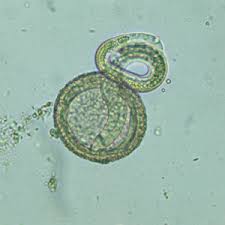 Parasitic nematodes can cause serious diseases and their emergence in new areas can be an issue of major concern for human health, agricultural productivity and biodiversity conservation. Molecular studies of nematode invasions can make a significant contribution to a better understanding of the underlying mechanism of the emergence, spread and persistence of the parasites. Also, they will clarify the evolutionary potential of the invaders in their new range and help with the elaboration of adequate management strategies against helminthic disease. The raccoon roundworm (Baylisascaris procyonis) is a common gastrointestinal parasite of the raccoon (Procyon lotor), that is emerging as an important helminthic zoonoses that mainly affects young children. Translocations of raccoons have increased the global geographic range of its roundworm as well. Raccoons are particularly abundant and wide-spread in Germany, where they can occur at high densities in urban areas. Recent genetic work has provided evidence for at least four independent introduction events, which gave rise to genetically differentiated subpopulations in incipient contact of relatively high genetic diversity. The roundworm, however, does not occur in all raccoon populations and might therefore be much less genetically diverse due to reduced propagule pressure. The overall objective of this study is to use population genetic techniques to analyse the genetic diversity and gene flow in the invasive nematode B. procyonis to understand the evolutionary potential of the parasite and allow the implementation of successful control programmes. We aim in particular to establish how frequently the parasite was introduced into Western Europe, to estimate the geographic origin of the introduced parasites, to examine the changes in genetic diversity during the invasion process and to the landscape genetic structure of the raccoon and its roundworm in parallel.
Parasitic nematodes can cause serious diseases and their emergence in new areas can be an issue of major concern for human health, agricultural productivity and biodiversity conservation. Molecular studies of nematode invasions can make a significant contribution to a better understanding of the underlying mechanism of the emergence, spread and persistence of the parasites. Also, they will clarify the evolutionary potential of the invaders in their new range and help with the elaboration of adequate management strategies against helminthic disease. The raccoon roundworm (Baylisascaris procyonis) is a common gastrointestinal parasite of the raccoon (Procyon lotor), that is emerging as an important helminthic zoonoses that mainly affects young children. Translocations of raccoons have increased the global geographic range of its roundworm as well. Raccoons are particularly abundant and wide-spread in Germany, where they can occur at high densities in urban areas. Recent genetic work has provided evidence for at least four independent introduction events, which gave rise to genetically differentiated subpopulations in incipient contact of relatively high genetic diversity. The roundworm, however, does not occur in all raccoon populations and might therefore be much less genetically diverse due to reduced propagule pressure. The overall objective of this study is to use population genetic techniques to analyse the genetic diversity and gene flow in the invasive nematode B. procyonis to understand the evolutionary potential of the parasite and allow the implementation of successful control programmes. We aim in particular to establish how frequently the parasite was introduced into Western Europe, to estimate the geographic origin of the introduced parasites, to examine the changes in genetic diversity during the invasion process and to the landscape genetic structure of the raccoon and its roundworm in parallel.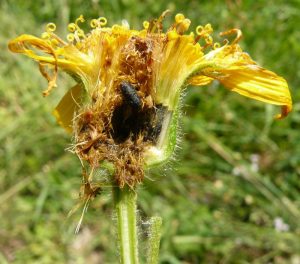 The biological diversity of montane regions may be threatened by predicted climate change. Low mountain species frequently cannot respond to climate change by migrating upward, but only by plasticity or genetic adaptation. Predicted climate change will not only result in changed environmental conditions, but also affect biotic interactions. The aim of this project is to study the possible impact of climate change on the interactions of the threatened plant species Arnica montana with both generalist herbivores and a specialised parasite, the seed fly Tephritis arnicae. We will investigate the impact of herbivory and parasitism on the model species A. montana along an altitudinal gradient, investigate defenses against herbivores using metabolomic profiles, and experimentally study how plant-animal interactions would be affected under predicted climatic change. Population sizes of generalist herbivores are foreseen to increase in upland regions which may threaten the survival of mountain populations of plants that may be less defended against herbivores than lowland populations. We will also study genetic variation in metabolomic profiles and herbivore resistance among and within populations and its importance for adaptation to changed conditions. The population biology of A. montana is currently studied in a PhD project (AFR FNR Grant) hosted by the MNHNL. The proposed PhD project will take advantage of the knowledge about the population biology and quantitative genetics of A. montana obtained in this study and use two common garden experiments already set up at high and low altitudes. The expected results of the project will contribute to a better understanding of the genetic and metabolomic diversity of rare and endangered species and its importance under the scenario of projected climate change. The outcomes will also have implications for the conservation and management of biodiversity and allow a better understanding of the role of systems biology in biodiversity conservation.
The biological diversity of montane regions may be threatened by predicted climate change. Low mountain species frequently cannot respond to climate change by migrating upward, but only by plasticity or genetic adaptation. Predicted climate change will not only result in changed environmental conditions, but also affect biotic interactions. The aim of this project is to study the possible impact of climate change on the interactions of the threatened plant species Arnica montana with both generalist herbivores and a specialised parasite, the seed fly Tephritis arnicae. We will investigate the impact of herbivory and parasitism on the model species A. montana along an altitudinal gradient, investigate defenses against herbivores using metabolomic profiles, and experimentally study how plant-animal interactions would be affected under predicted climatic change. Population sizes of generalist herbivores are foreseen to increase in upland regions which may threaten the survival of mountain populations of plants that may be less defended against herbivores than lowland populations. We will also study genetic variation in metabolomic profiles and herbivore resistance among and within populations and its importance for adaptation to changed conditions. The population biology of A. montana is currently studied in a PhD project (AFR FNR Grant) hosted by the MNHNL. The proposed PhD project will take advantage of the knowledge about the population biology and quantitative genetics of A. montana obtained in this study and use two common garden experiments already set up at high and low altitudes. The expected results of the project will contribute to a better understanding of the genetic and metabolomic diversity of rare and endangered species and its importance under the scenario of projected climate change. The outcomes will also have implications for the conservation and management of biodiversity and allow a better understanding of the role of systems biology in biodiversity conservation.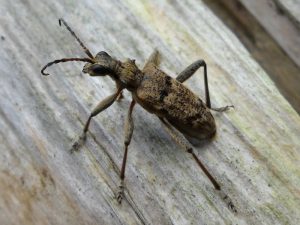
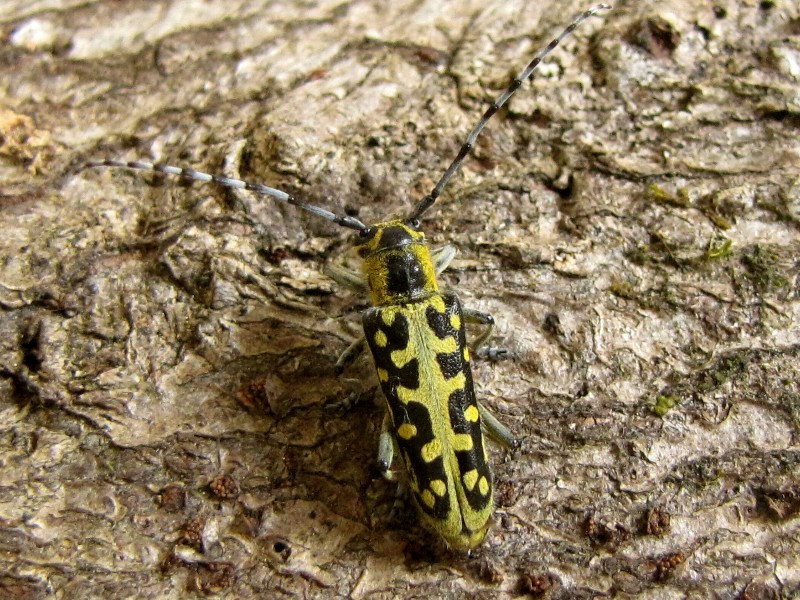


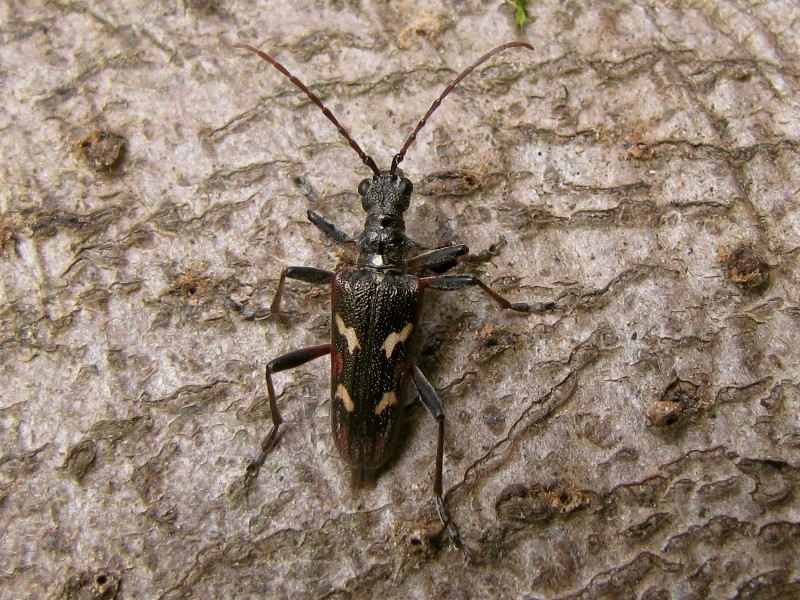
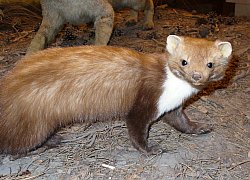 It is common practice to rehabilitate wounded or orphaned wildlife with the intention of re-releasing them into the wild, or to capture, trans-locate and re-release animals that cause disturbance to humans or damage property. The proposed project aims to investigate the post-release behaviour of stone martens (Martes foina) and to assess the welfare implications and practical efficiency of re-release as a management strategy. Stone martens have been chosen as subjects because they are common in urban and rural environments throughout most of Europe including Luxembourg, and they are responsible for various sources of human/wildlife conflict. Captive reared orphaned and wild-caught adult stone martens will be radio tracked after rerelease, and their behaviour and survival rates recorded under two different release regimes (‘soft’ and ‘hard’ release). A questionnaire survey will be conducted to see whether the problems that led to the capture and relocation of the wild-captured adult martens ceased after the removal of the martens from their territory; or whether the territory was reoccupied and the problems persisted. The overall aim of the study is to improve re-release protocols so as to (a) optimize the chances of survival and the welfare of the re-released stone martens after and during the process of release, and to (b) minimize the likelihood of further human/wildlife conflict.
It is common practice to rehabilitate wounded or orphaned wildlife with the intention of re-releasing them into the wild, or to capture, trans-locate and re-release animals that cause disturbance to humans or damage property. The proposed project aims to investigate the post-release behaviour of stone martens (Martes foina) and to assess the welfare implications and practical efficiency of re-release as a management strategy. Stone martens have been chosen as subjects because they are common in urban and rural environments throughout most of Europe including Luxembourg, and they are responsible for various sources of human/wildlife conflict. Captive reared orphaned and wild-caught adult stone martens will be radio tracked after rerelease, and their behaviour and survival rates recorded under two different release regimes (‘soft’ and ‘hard’ release). A questionnaire survey will be conducted to see whether the problems that led to the capture and relocation of the wild-captured adult martens ceased after the removal of the martens from their territory; or whether the territory was reoccupied and the problems persisted. The overall aim of the study is to improve re-release protocols so as to (a) optimize the chances of survival and the welfare of the re-released stone martens after and during the process of release, and to (b) minimize the likelihood of further human/wildlife conflict.